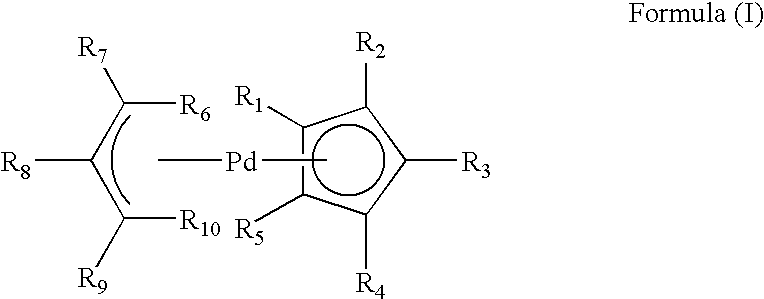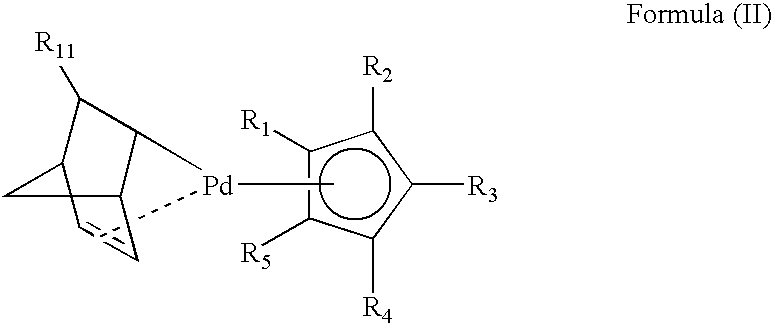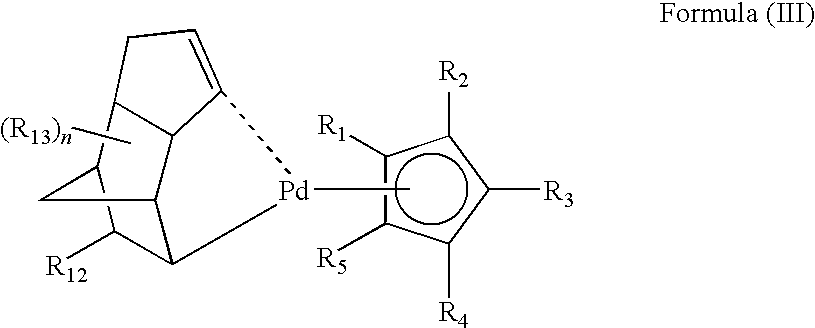Organometallic compound, catalyst for polymerization of polar group-containing norbornene and process for producing norbornene polymer
a technology of organic compounds and norbornene, which is applied in the direction of catalyst activation/preparation, group 5/15 element organic compounds, and group 3/13 element organic compounds, etc., can solve the problems of yellowing of films and reducing the light transmission of films, and achieve excellent polymerization, high transparency, and small size
- Summary
- Abstract
- Description
- Claims
- Application Information
AI Technical Summary
Benefits of technology
Problems solved by technology
Method used
Image
Examples
example 1-1
[0236]Methyl norbornene carboxylate M-1 (ratio of endo / exo=51 / 49; manufactured by Tokyo Kasei) (20.0 g) as a monomer and 40 mL of toluene were charged in a glass container where inner air was substituted with highly pure argon and were stirred with a stirring fan. A solution where 13.6 mg of an organopalladium complex as (a) was dissolved in 0.5 mL of toluene, a solution where 4.9 mg of triphenyl phosphine P(C6H5)3 (manufactured by Wako Pure Chemical Industry) (4.9 mg) as (b) was dissolved in 0.5 mL of toluene and a solution where dimethylanilinium tetrakispentafluoro borate (CH3)2(H)NC6H5.B(C6F5)4 (manufactured by Strem) (54 mg) as (c) was dissolved in 1 mL of methylene chloride were added thereto. The mixed solution was heated until the inner temperature became 90° C. and the reaction was carried out for 6 hours by keeping the temperature at 90° C. After completion of the reaction, the reaction solution was added to 300 mL of methanol. The resulting white solid was sucked and drie...
examples 1-2 to 1-9
[0238]The same experiment as in Example 1-1 was carried out where the neutral organopalladium complex (a), the organophosphorus compound (b), the salt (c) and the monomer were changed as shown in the following Table 1. Molar equivalents in each Example were the same as those in Example 1-1.
example 1-10
[0239]The same experiment as in Example 1-1 was carried out except that the monomer was changed to M-1 and norbornene (NB) in a molar ratio of 70 / 30.
PUM
| Property | Measurement | Unit |
|---|---|---|
| temperature | aaaaa | aaaaa |
| temperature | aaaaa | aaaaa |
| temperature | aaaaa | aaaaa |
Abstract
Description
Claims
Application Information
 Login to View More
Login to View More - R&D
- Intellectual Property
- Life Sciences
- Materials
- Tech Scout
- Unparalleled Data Quality
- Higher Quality Content
- 60% Fewer Hallucinations
Browse by: Latest US Patents, China's latest patents, Technical Efficacy Thesaurus, Application Domain, Technology Topic, Popular Technical Reports.
© 2025 PatSnap. All rights reserved.Legal|Privacy policy|Modern Slavery Act Transparency Statement|Sitemap|About US| Contact US: help@patsnap.com



